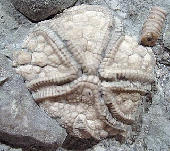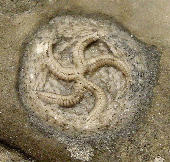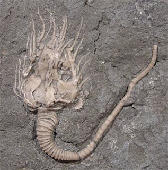|
 See More Images See More Images
(20 total)

Edrioaster bigsbyi
© 2006 Joe Koniecki

Foerstediscus grandis
© 2006 Joe Koniecki

Glyptocystites multiporus
© 2006 Joe Koniecki
|
What are Other Echinoderms? This group includes some living forms (holothurians) and some extinct forms that are very distinct from the Seastars, Echinoids, and Crinoids. Holothurians, or sea cucumbers, lack the typical calcium carbonate skeleton of most echinoids; their skeletal elements have been reduced to microscopic plates called spicules. The extinct forms, such as edrioasteroids, cystoids, blastoids, and helicoplacoids, appear to have been early evolutionary “experiments” on the basic echinoderm body plan. First and last occurrences of members of this group vary. For example, edrioastroids first appeared in the Cambrian and went extinct in the Carboniferous; holothurians first appeared in the Silurian and are still present today. First known fossil occurrence: Cambrian. Last known fossil occurrence: Quaternary. This group has living relatives. Cool Other Echinoderms links: Search for images of Other Echinoderms on Google |
See Other Echinoderms from the:
|
|




